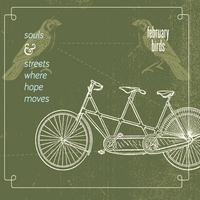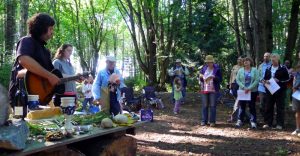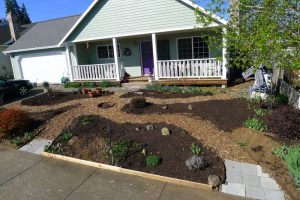By Andy Wade –
When you step outside, taste it in the air tonight, the faintest flavor rushing by, hope is living here. When you walk your street, can you feel it in your feet, the sanctuary sidewalk heat, hope is living here.
 These are the first two lines from “Fierce Hope” by February Birds (a.k.a. Sean and Julie Hall). Sometimes it’s easier to be overwhelmed by the difficulties in our neighborhood than it is to taste hope in the air. And what of sanctuary? It can be easy to assume that all these homes are havens of peace and security, but just a quick glance at domestic statistics makes clear that just isn’t so.
These are the first two lines from “Fierce Hope” by February Birds (a.k.a. Sean and Julie Hall). Sometimes it’s easier to be overwhelmed by the difficulties in our neighborhood than it is to taste hope in the air. And what of sanctuary? It can be easy to assume that all these homes are havens of peace and security, but just a quick glance at domestic statistics makes clear that just isn’t so.
What might it mean to share the flavor of hope and sanctuary in my neighborhood? Jesus did instruct us to love both God and neighbor, but how do I do that? What does loving God and neighbor look like?
This is a question I’ve been asking myself the past couple of years. My yard and my home are my sanctuary. But should they not also be available to those around me? Should I not also be more available to those around me?
As I thought about this I remembered these words from the Apostle John:
“On the last and greatest day of the festival, Jesus stood and said in a loud voice, “Let anyone who is thirsty come to me and drink. Whoever believes in me, as Scripture has said, rivers of living water will flow from within them.” John 7:37-38
Hearing these words, I realized how often I focus on the invitation to “come and drink” but not on what it means to have “living water flow from within”.
What about the way I live is received by those around me as living water?
How might the living waters within be stagnant, stale and on the way to becoming undrinkable?
How might the “water” flowing from me actually be toxic instead of life-giving?
 Mustard Seed Associates has 40 wooded acres out on Camano Island in Washington State. Several years ago water was located and a well drilled and tapped, then it was capped off, waiting for the money we needed to have it certified and transformed into a functional source of refreshment.
Mustard Seed Associates has 40 wooded acres out on Camano Island in Washington State. Several years ago water was located and a well drilled and tapped, then it was capped off, waiting for the money we needed to have it certified and transformed into a functional source of refreshment.
This acreage is the location of our annual Celtic Prayer Retreat (this year on August 5-7). Because we haven’t been able to finish the well, we’ve reminded our participants to bring their own water. It seems odd to have such an abundant source of fresh water right there on the property but no way to access it!
The living waters Jesus mentions arise from a bottomless well, but often we cap the well, making it inaccessible to the world around us.
Back in my neighborhood, with these things in mind, I began wondering, what are the refreshing sources of abundance in my yard and home that are freely accessible to our neighbors, and which are capped, inaccessible to those living around me?
 Two years ago we turned our front yard into a garden. Various paths lead from the sidewalk into the yard, inviting neighbors and strangers to wander in, sit on the bench, grab a book from the “Little Free Library”, or pick some herbs from the community herb and sun tea garden. This is a great start! We really can choose how our environment is shaped to either welcome or exclude, to be a well of living water or a well whose water is not available to refresh our neighbors.
Two years ago we turned our front yard into a garden. Various paths lead from the sidewalk into the yard, inviting neighbors and strangers to wander in, sit on the bench, grab a book from the “Little Free Library”, or pick some herbs from the community herb and sun tea garden. This is a great start! We really can choose how our environment is shaped to either welcome or exclude, to be a well of living water or a well whose water is not available to refresh our neighbors.
But Wait, There’s More!
There’s a fountain down, in the center of our town, it’s old and been forgotten now, one day it will rush. It will flood our street, bubble up with heaven’s dreams, care and friendship deep like seeds, hope is living here.
This second verse from February Birds’ “Fierce Hope” takes me deeper into the garden as a source of hospitality, of “friendship deep like seeds”… literally!
As we celebrate the resurrection and discover new ways to practice resurrection, in my garden I noticed all the new volunteer plants springing up: mint, lemon balm, oregano, sage, chives… I know as the weather warms these volunteers will be joined by calendula, bee balm, nasturtiums, borage, and more.
The wheels began to turn! What if I add a table next to the Little Free Library – a kind of little free plant exchange? I know I’m not the only one in the neighborhood with too many volunteers springing to life in the garden! What might happen if we began to share?
Then I thought a bit more… I’ve got around 300 seed starts just now bursting through the surface in carefully planted containers. I always plant more than I need and, because you never know how well seeds will grow, you always plant at least two seeds per container. What if, instead of cutting and discarding the extras, I carefully extracted the extra seed starts and replanted them in another container? What if, rather than discarding my extras, I shared with my neighbors out of my abundance?
Yes, I’m aware that the proper way to start seeds is to choose the strongest and snip off the others, thus protecting the root system of the strongest one. But what if I were to take that chance, maybe even have a weaker beginning to my own garden, in order to share with others? What does it mean to love a sacrificial God and the neighbor in my community? Perhaps it’s not all about getting the best garden ever for myself!
I remember when my wife and I were speaking at a Mennonite Church in South Dakota. Years ago we stayed with retired farmers, and on our way home from Sunday service we passed fields of workers busy with the business of harvesting. Our host commented, “Why do they have to do that on the Sabbath?” My first reaction was, “Oh, how quaint.” But the question stuck with me.
Traditional farmers have bushels of faith. Every little change in weather seems to affect their very livelihood. And yet for so many, Sunday was a day of rest. Rest for the family, rest for the land. This profound act of faith, especially during the height of the harvest, is amazing! It is to trust the “Lord of the Harvest”, the one who commanded the Israelites in the wilderness to only gather enough manna for each day – their daily bread – except on the sixth day to gather enough for the Sabbath day of rest as well.
You can bet that as I carefully extract the extra seedlings from their pots and gently plant them in a new home, I will be remembering these acts of gardening and harvesting faith. Going against conventional wisdom is often the very path of faith. And doing so as a gift to neighbor and stranger seems fitting as I learn to more fully love God and neighbor through simple acts in the garden.
There’s not really a conclusion to this post; it’s a beginning, not an ending. But I hope you’ll take some time to listen to February Birds’ “Fierce Hope”.
As you listen, reflect on your own neighborhood:
- Can you taste the hope?
- Can you see the fountains of living water? The seeds of God’s fierce hope?
- With what you already have, how might you enter into your neighborhood as a garden of refreshment?
This article was first published as “Gardens of Reconciliation” on the Mustard Seed Associates’ blog, but has been reworked and adapted for Godspace.

4 comments
Do people actually pick from your garden and linger on the bench?! All my suburban etiquette tells me that I wouldn’t accept such an invitation and would keep going on the sidewalk…and yet I feel so much hope that this could work as a place of connection.
It’s a work in progress, Kate. Our Little Free Library is used way more than I ever expected – a wonderful exchange of books. A few people have sat on the bench and I don’t know if anyone’s actually picked from the garden yet. Our neighbors love the idea and we freely share with them out of the garden, but your’re right, “suburban etiquette” runs deep and it seems we have to relearn how to be neighbors. Right now we are at the place where several of our neighbors do walk around to other neighbor’s homes to share the over-abundance from their gardens. And, although we don’t yet have many feeling comfortable enough to break that front yard barrier, we do have folks stop by and ask questions both about what we’re doing and how we’ve done it. Anything that opens us up to welcoming one another is huge in our world of self-imposed seclusion. Thanks for your comment!
I can’t find the full lyrics to this song. Do you have them?
Eric, I did a search and found it on spotify. Hope that helps